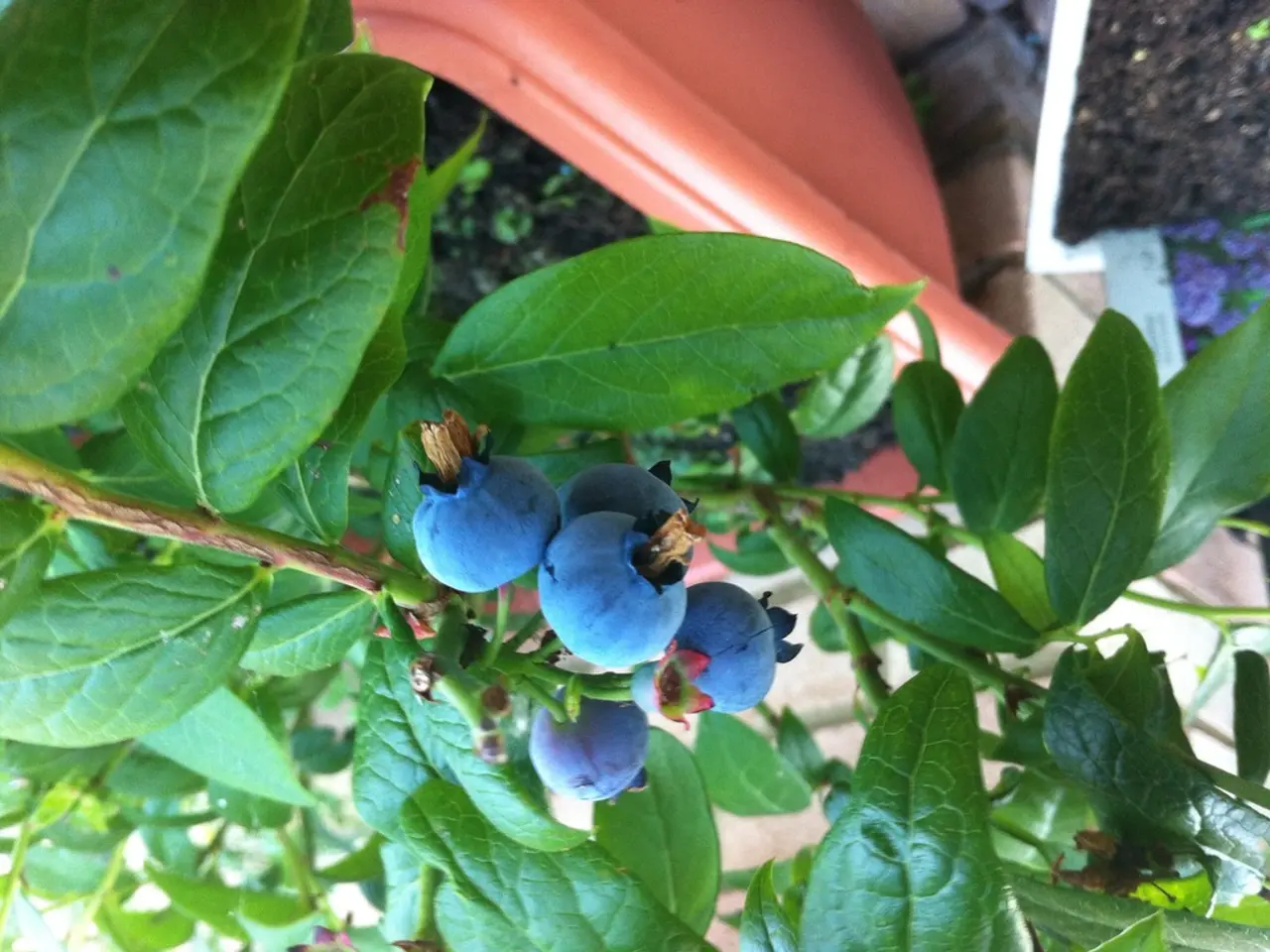Cultivating Blueberries in Your Personal Backyard Garden
Growing Blueberries at Home: A Comprehensive Guide
Blueberries are a popular choice for home gardeners due to their minimal space requirements and low spray requirements. Here's a step-by-step guide on how to cultivate these delicious fruits in your garden.
Soil Preparation
The best soil conditions for growing blueberries at home are very acidic soil with a pH between 4.5 and 5.5, rich in organic matter, well-drained but consistently moist, and high in compost or organic material to retain moisture and nutrients [1][3][5]. If your soil pH is above 5.7, you may need to acidify it using elemental sulfur. Conversely, if it's below 4.5, lime can be added carefully to raise pH toward 5.5 [1][5].
Incorporate several inches of well-aged compost into the top 8–12 inches of soil before planting. This improves nutrient content, moisture retention, and helps maintain acidity [1][5]. For optimal results, use a soil mix with good aeration and drainage, such as an equal parts combination of peat moss (acidic), pine bark, and perlite or sand, especially for container planting [3].
Watering
Blueberry bushes have very shallow root systems and are very sensitive to water fluctuations. They require at least 1 to 2 inches of water per week [1][3]. Using a soaker hose is an excellent way to deliver water to blueberry plants. Supplemental watering is essential to obtain good yields of high-quality fruits during the growing seasons.
Planting and Pruning
Blueberry plants normally do not need much pruning for the first three years. Remove small and spindly shoots at planting, and remove blossoms that appear in the year of planting and second year after planting to stimulate vigorous growth [1][3]. Blueberry plants should not be allowed to bear fruit during the first two years after planting or until the plants reach a height of 2.5 feet.
In the fourth year, the dormant plants should be pruned in mid-March. At this time, remove dead and weak branches and thin, terminal wood with small buds. Prune interior crossing branches to admit light to the center of the plant [1][3]. In subsequent years, remove a few older branches to force new shoot growth from the crown. The tall growing branches can be headed back, and thin branches removed.
Fertilization
Blueberry plants require annual fertilization. Apply 1 to 1.5 pounds of ammonium sulfate or 2 to 3 pounds of 10-10-10 per 100 feet of row each year for fertility and acidity maintenance [1][3]. Container-grown blueberry plants may produce berries during the year of planting.
Mulching
Generous use of mulches such as sawdust, wood chips, or peat moss will help control weeds, conserve moisture, and keep roots cool. Increased organic matter from decomposing mulch will help improve the soil structure and nutrient uptake for the blueberry bush.
Troubleshooting
If plant leaves become chlorotic, apply 2 to 3 ounces of ferrous sulfate or iron chelate around the base of the plants each year [1][3]. Highbush blueberries do not require two different cultivars for cross pollination [1][3].
In conclusion, acidic, well-draining, organic-rich soil kept moist is essential for healthy blueberry growth at home. Adjust soil pH and enrich with compost and acidic organic materials for best results [1][3][5]. With the right care and attention, you can enjoy a bountiful harvest of blueberries in your own backyard.
[1] Ohio State University Extension. (2021). Blueberries. https://ohioline.osu.edu/factsheet/hyg-2144
[2] University of Maine Cooperative Extension. (2021). Growing Blueberries. https://extension.umaine.edu/publications/4418e/
[3] Michigan State University Extension. (2021). Blueberry Production. https://www.canr.msu.edu/news/blueberry_production
- To maintain a healthy lifestyle and enhance your home-and-garden horticulture, consider the methodical cultivation of blueberries, which thrive in acidic soil with organic matter, providing delectable fruits for your household.
- For optimal blueberry growth and pest management, ensure your soil is acidic, well-drained, and rich in organic matter while keeping it consistently moist, especially in the initial stages of planting, to encourage strong root development.
- To successfully grow blueberries at home and enjoy a vibrant crop, invest in a comprehensive gardening approach that includes adjusting soil pH, enriching soil with compost and acidic organic materials, maintaining proper watering and fertilization, incorporating mulch for weed control, and practicing pruning techniques to promote healthy growth and fruitfulness for your blueberries in the years to come.




